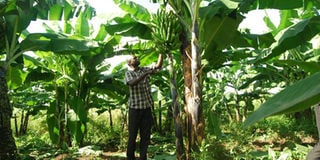High school dropout finds fortune in banana farming

Simon Ongom trims banana leaves on his five-acre farm. PHOTO BY ALICE ADIKIN.
What you need to know:
- At 27, Simon Ongom is an employer, has a home and is a successful banana farmer in Amuru District, writes Alice Adikin
They say every dark cloud has a silver lining and that is how best to describe Simon Ongom’s perception about life. The 27-year-old had to drop out of school in 2010 when he was in Senior Six after his brother, who was paying his school fees, died.
The resident of Guruguru parish, Lamogi Sub-county, Amuru District, says when he looked at the responsibilities that awaited him, his siblings and the late brother’s seven children, all looked up to him. Realising that finishing school to get a formal education would not help his big family, Ongom decided to think outside the box.
Start
“Thankfully the family had ancestral land near Guruguru Hills. Armed with knowledge that bananas flourish on hillsides, I took a gamble and planted bananas believing it will come in handy to support the family,” he says.
Ongom says when National Agricultural Advisory Services (Naads) was enrolling farmers for training he also registered and was trained on banana and coffee planting, spacing and management. “In 2012, I got 1,350 banana suckers which I planted on three acres of land,” he says.
In between the plantations, he grew coffee that he had got from Uganda Coffee Development Authority through Naads. He later expanded to five acres when he saw that bananas were flourishing.
He says venturing into banana farming is one of the best things that have happened to him. It has given him an opportunity to employ others as well as take care of his family.
Labour
Ongom has three full time labourers whom he pays Shs70,000 each per month. When the work is a lot, he solicits the services of casual labourers whom he pays wages of Shs3,000 each per day. He also provides a simple lunch for the days worked. These workers tend his coffee plantations as well.
Market
Ongom says he has market for his bananas and his supply is enough to satisfy all his clients, the harvest is done twice a year. He sells them in bulk to customers who come with trucks and buy direct from the garden.
Apart from the direct sales, Ongom sells to hoteliers and restaurant around Gulu and Amuru towns. His other customers are at the South Sudan border where he ferries the produce by motorcycle.
The price of bananas ranges from Shs10,000 to Shs15,000 per bunch and he makes a profit of Shs800,000 every season.
Benefits
With the profits he earns from bananas has managed to take care of all the family members plus providing all their basic needs and paying school fees for all the orphans left under his care he says.
He has also managed to build a house in the village and bought three motorcycles which he uses to transport his produce as well as offer boda-boda services.
Because he has multiplied many suckers he sells them and that is added income to his projects.
Challenges
Ongom says his major challenge is transportation. When it rains he gets stuck because of the mud. He also faces the challenge of seasonal price fluctuation in the market, high labour costs and low production during the dry season.
Plans
Ongom says he does not want to expand his five-acre banana plantation. “I want to venture into other businesses like hardware to supplement on farming,” he says. He also wants to add value to his produce by drying and packaging so that he can tap into the export market as well as supermarkets.
Maintenance
Ongom maintains his farm by constant weeding, where he removes excess suckers and cuts the top dead fingers to avoid transfer of diseases. He also trims the banana leaves and removes the dry leaves that he uses for mulching because he does not use manure.
When the yield is too heavy, he supports his plantations with the poles to prevent wind from breaking them down.
Best practices for growing bananas
Matooke is one of the crops that is most grown around the country on both large or small scale. It is one of the important economic resources for rural farmers in Uganda.
The crop is grouped into types which include; cooking brand, nakabululu and muvubo; beer banana; kiasubi Kayinja, roasting banana; gonja and dessert banana; bogoya, ndizi (apple banana).
These are steps on how to grow matooke, they include;Planting
Dig holes at least 60 cm (2ft) in diameter and 60 cm (2ft) deep. Half fill the top soil mixed with rotted manure before putting in to the planting hole. A cover crop like beans, groundnuts should be inter-planted.
It is advisable to plant at the beginning or during the main rain season for proper establishment and subsequent production.Spacing
Spacing varies with type of bananas. All types of bogoya are widely spaced and short ones like nakytengu are closely spaced. On average, spacing is 3m x 3m (10ft x 10ft); ranging from 2.4 m to 4.5 m between the holes giving a plant population of 750 – 900 per hectare.Fertiliser application
For proper production, a good supply of nutrients is needed. The crop will benefit from farm yard manure if available or a dressing of 500gm of single superphosphate, 500gm muriate of potash and 500gm of calcium-ammonium-nitrate at planting.Weed control
Weed infestation can cause a drop in banana yield, therefore, weeds must be controlled either by mechanical weeding or by herbicides like gramoxone. For a mature established field mulching with coffee husks, elephant grass or other dry seedless grasses is a recommended practice against weeds.-Compiled by Carol B. Atangaza




